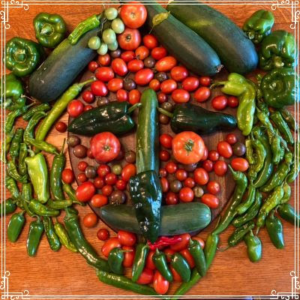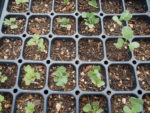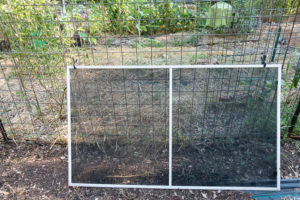
Enjoy your harvest! Photo courtesy of Kerry Drake, Sunshine Community Gardens
It’s Dry in the July Vegetable Garden
If you’re a new gardener in the Austin area, you’re probably wondering what you’ve gotten yourself into.
The U.S. Drought Monitor tells the story. Over 2/3 of Travis County is now tagged as experiencing extreme drought. Dry conditions mean that the soil has a reduced capacity to capture and store heat, exacerbating the high temperatures we are already experiencing.
High nighttime temperatures cause many varieties of tomatoes to produce sterile pollen, which means your plants are going to stop fruiting (if they haven’t already.) Cherry tomatoes aren’t as impacted, but even they might be suffering in the heat. If your garden has become infested with scale, whiteflies, or overrun by beetles, it’s time to cut those plants off at the ground and contribute them to the compost bin. It’s not worth the water to try to keep stressed plants alive through the summer. Cut your losses and let’s get on with fall gardening!
Start Planning the Fall Garden
Yes, that’s right, it’s time to think about fall gardening. July is a great month to get your fall tomatoes and broccoli started. It’s also a good use of your time while hiding in the house from the heat. Choose varieties that mature in 65 days or less. Use a peat-free seed starting mix and find a location with bright indirect sunlight (or use grow lights.)
While choosing what to plant for fall, sketch out a rotation plan for growing vegetables. Crops within the same family are often susceptible to the same pests or diseases. Moving or rotating them to a different location helps break the pest/disease cycle.
If you’re still determined to slog it out in the heat, wear long sleeves and a wide-brimmed hat to protect yourself from the sun. I’m picking okra every day right now and have planted enough for a continuous harvest right through to frost. Okra is originally from Africa and can tolerate (and prefer) our hot summers. You can still plant sweet corn this month too. Just keep it watered until well established. Make sure to lightly mulch around the stalks to keep the soil from drying out. I like using composted leaves (from all those leaves I gathered from the neighborhood last fall.) Composted pine needles work great too. They usually come from East Texas, and you can find them at local nurseries or farm supply stores.
July Vegetable Garden Checklist:
Water
- Irrigate deeply and as infrequently as possible to encourage deep root growth. Water in the morning so that plants can use the moisture during the heat of the day.
Soil
- Keep garden beds mulched, adding or replacing mulch as necessary. Be sure to mulch empty beds to conserve moisture and protect the soil and microorganisms from the heat in anticipation for fall planting.
Fertilize
- Over-fertilizing in summer is a common plant killer. Excess fertilizer (especially nitrogen) can burn plants in dry weather. This happens because the salts in fertilizer draw moisture out of plants that they are not able to replenish from soil moisture or retain due to evaporation on hot days. Lack of moisture results in scorched leaves resembling fire damage, or “burn”. Use liquid fertilizers and be sure to water deeply.
Plant/Transplant
- Peruse the seed catalogs and place your order for fall planting.
- Tomato transplants should be planted in the garden by late July or early August in order to set fruit and produce a harvest before the first freeze. Grow your own from seed planted indoors the first week of July.
- Plant pumpkins by mid-July to harvest before Halloween. Most varieties take 90-100 days to mature.
- Plant zinnia and marigold seeds now for a vivid fall display. You’ll have to water them regularly.
- It takes about 6 weeks to grow a broccoli or kale transplant from seed. Start planting seeds of broccoli, cauliflower, cabbage and other cole crops so they will be ready for setting in the garden by mid-September.

Start broccoli or kale seeds to transplant in fall.
- You can still plant southern peas, okra, and sweet corn this month if you keep the soil moist while they are establishing deep roots.
- Prepare for transplants by watering and mulching designated planting areas for a few days before adding plants.
Diseases/Pests to Look For
- Pull up any tomato plants infested with pest damage or disease. Whatever malady they are suffering from will get worse, not better, during the stress of summer heat. Use green tomatoes for roasted tomato salsa, chow-chow relish, fried green tomatoes, or chop and add to a vegetable sauté.
Maintenance
- Pull up any tomato plants that are infested with pest damage or disease. Whatever malady they are suffering from will get worse, not better, during the stress of summer heat. Use green tomatoes for roasted tomato salsa, chow-chow relish, fried green tomatoes, or chop and add to a vegetable sauté.
- Peppers and eggplant handle Texas heat better than tomatoes. Keep them watered and mulched and, even if they pause production during summer’s peak, they will power through and produce a bumper crop this fall.
- Provide birds fresh water daily during the summer. Place the birdbath in an open area with shrubs or trees nearby where birds can have easy access and observe possible threats. They will help control summer caterpillars and locusts.

Use shade cloth, old window screens, bed sheets or burlap to fashion a temporary shade covering for new transplants.
- Providing shade cloth helps protect tender plants from afternoon sun. Fashion a temporary covering using shade cloth, old screens, umbrellas, etc.
Harvest
- Harvest okra pods frequently before they get too big; over-grown okra is tough and stringy.
- Beat the squirrels by harvesting tomatoes when they start to show some color. Bring the fruit inside the house to finish ripening on a table or a countertop.
- Herb infused water is a great pick-me-up for hot days. Throw in a few cucumber slices if you have them.
Additional Resources
Watch the Vegetable Gardening in Central Texas Webinar
Vegetable Planting Calendar (English) (Español) (繁体中文)
Recommended Vegetable Varieties for Travis County
Plant Rotations, Successions and Intercropping
Monthly Gardening Calendar for Austin and Central Texas
About Sheryl Williams
 Sheryl Williams has been a Travis County Master Gardener since 2010 and currently works as the Horticulture Program Assistant at Texas A&M AgriLife Extension – Travis County. She was introduced to gardening by her mom and grandma and has been an avid vegetable gardener most of her life. Sheryl believes that there is nothing more satisfying than growing and preparing your own food. She likes gardening in Austin year round and concedes that means pulling weeds every day. She practices organic gardening principles and enjoys the challenge of outsmarting garden pests. Occasionally she loses these battles, but doesn’t mind sharing a good meal.
Sheryl Williams has been a Travis County Master Gardener since 2010 and currently works as the Horticulture Program Assistant at Texas A&M AgriLife Extension – Travis County. She was introduced to gardening by her mom and grandma and has been an avid vegetable gardener most of her life. Sheryl believes that there is nothing more satisfying than growing and preparing your own food. She likes gardening in Austin year round and concedes that means pulling weeds every day. She practices organic gardening principles and enjoys the challenge of outsmarting garden pests. Occasionally she loses these battles, but doesn’t mind sharing a good meal.

